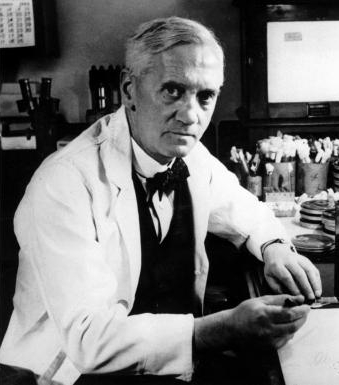
What Is Modern Medicine?
Economic activity grew rapidly during the 18th Century in Western Europe and the Americas. It was the beginning of the Industrial Revolution. During the 19th century economic and industrial growth gathered pace; it was also a period of scientific discovery and invention.
Old ideas of infectious disease epidemiology (incidence, distribution, and control of diseases) made way to virology and bacteriology. Microbiology made advances, a science that started with Antonie Philips van Leeuwenhoek (1632 – 1723), who first observed microorganisms with a microscope.
Enormous development s were made in identifying and preventing illnesses. However, one problem still persisted, and that was treating and curing infectious diseases.
During the 19th century the world changed dramatically:
- Industry expanded enormously, and with it came various work-related diseases, such as “phossy jaw” (jaw necrosis among those working with phosphorous, usually in the match industry), lung diseases and dermatitis.
- Hygiene – Ignaz Semmelweis (1818-1865) brought down the childbed fever death rate among new mothers by insisting that doctors wash their hands before touching women during childbirth. It was not until 1865 when Joseph Lister, a British surgeon proved the principles of antisepsis in wound treatment. Even then, it was an uphill struggle to convince all the “conservative” doctors.
- Cities started to grow rapidly, and so did urban sprawl. Health problems, such as typhus and cholera became more common
- Some European countries had empires, including the UK, Spain, Portugal, France and some others. People travelled to and from various parts of the world, bringing back with them various diseases, such as yellow fever.
- Scientific breakthroughs appeared all over Europe and the Americas, including the electrocardiograph.
- Postal services and communications in general improved, allowing medical knowledge to spread rapidly.
- Democracy grew in several countries in Europe and the Americas. This led to people demanding health as a human right.
- Innovative scientists advanced forward despite resistance from the clergy, examples include Charles Darwin (evolution) and Gregor Johann Mendel (genetics).
- Wars – as technology developed, wars became more devastating, causing mass injuries, which required new surgical and medical techniques.
Timeline of medical milestones during the 19th century
Timeline of medical milestones during the 20th century
- 1901 – Different human blood types were discovered by Karl Landsteiner (1868-1943), an Austrian biologist and physician. He identified the presence of agglutinins in blood and developed the modern system of classifying blood groups. He received the Nobel Prize in Physiology or Medicine in 1930.
- 1901 – The first case of Alzheimer’s disease was identified by Alois Alzheimer (1864-1915), a German psychiatrist and neuropathologist. He called it “presenile dementia”. His colleague, Emil Kraepelin, later called the it Alzheimer’s disease.
- 1903 – The first practical electrocardiogram (ECG or EKG) was invented by Willem Einthoven (1860-1927), a Dutch doctor and physiologist. In 1924 he received the Nobel Prize in Medicine in 1924.
- 1906 – Vitamins were discovered by Frederick Hopkins (1861-1947), an English biochemist. He also suggested that scurvy and rickets were caused by a lack of vitamins. Along with Christiaan Eijkman, he received the Nobel Prize in Physiology or Medicine.
- 1907 – A chemotherapeutic cure for sleeping sickness was developed by Paul Ehrlich (1854-1915), a German doctor and scientist. Ehrlich’s lab also discovered Arsphenamine (Salvarsan), the first treatment for syphilis that was effective, and thus initiated and named the concept of chemotherapy.
- 1908 – The stereotactic method (stereotactic device) was invented by Victor Horsley (1857-1916) and R. Clarke. It allows experimental and surgical intervention in deep-seated structure of the brain.
- 1910 – The first laparoscopy performed on a human was done by Hans Christian Jacobaeus (1879-1937), a Swedish internist. Jacobaeus became a professor at the prestigious Karolinska Institute in Stockholm, and was also a member of the Nobel Prize Committee.
- 1921 – Vitamin D discovered by Sir Edward Mellanby (1884-1955), a British physician. He also explained Vitamin D’s role in preventing rickets.
- 1921 – Insulin was discovered by Sir Frederick Banting (1891-1941), a Canadian medical scientist, and Charles Herbert Best (1899-1978), an American-Canadian medical scientist. Banting received the Nobel Prize in Medicine in 1923 (along with John James Rickard Macleod) when he was 32 years old. He is still the youngest ever Nobel Laureate for Medicine.
- 1921 – The technique of epidural anesthesia was pioneered by Fidel Pagés (1886-1923), a Spanish military surgeon.
- 1923-1927 – The first vaccine for diphtheria, pertussis (whooping cough), TB (tuberculosis) and tetanus were developed and used successfully.
-

Sir Alexander Fleming, FRSE, FRS, FRCS(Eng)
1928 – Penicillin from the mould Penicillium notatum was discovered by Sir Alexander Fleming (1881-1955), a Scottish biologist and pharmacologist. He was awarded the Nobel Prize in Physiology or Medicine in 1945, along with Howard Florey and Ernst Boris Chain.
The discovery of penicillin changed the course of history and saved hundreds of millions of lives.
Fleming said: “When I woke up just after dawn on September 28, 1928, I certainly didn’t plan to revolutionized all medicine by discovering the world’s first antibiotic, or bacteria killer ……. But I suppose that was exactly what I did.”
- 1929 – Human electroencephalography was discovered by Hans Berger (1873-1941), a German doctor. He was the first to record brain waves or EEGs (electroencephalograms). He discovered the alpha wave rhythm in the brain, which is also known as “Berger’s wave”.
- 1932 – A chemotherapeutic cure for streptococcus was developed by Gerhard Domagk (1895 -1964), a German pathologist and bacteriologist. He is credited with discovering Sulfonamidochrysoidine (KI-730), the first antibiotic to go on the market (brand name: Prontosil). He was awarded the Nobel Prize in Physiology or Medicine in 1939.
- 1933 – Insulin shock therapy for patients with some mental illnesses was discovered by Manfred Sakel (1900-1957), a Jewish Austrian neurophysiologist and psychiatrist who later became an Austrian-American.
- 1935 – The first successful vaccine for Yellow Fever was developed. The yellow fever virus was isolated in West Africa in 1927; this led to the development of two vaccines in the 1930s. 17D was developed by Max Theiler, a South African microbiologist at the Rockefeller Institute. He used chicken eggs to culture the virus. Theiler was awarded the Nobel Prize in 1951.
- 1943 – The world’s first dialysis machine was built by Willem J Kolff (1911-2009), a Dutch doctor. He is known as a pioneer of hemodialysis and artificial organs. In 1950, Kolff emigrated to the USA.
- 1946 – The first effective cancer chemotherapy drug – nitrogen mustard – was discovered by Alfred G. Gilman (1908-1984) an American pharmacologist, and Louis S. Goodman (1906-2000), also an American pharmacologist, while doing research together at Yale University. They discovered that the blood of soldiers who had been exposed to nitrogen mustard had exceptionally low levels of white cells.
- 1948 – Acetaminophen (paracetamol, Tylenol) was invented by Julius Axelrod (1912-2004), an American biochemist, and Bernard Brodie (1907-1989), an American chemist, considered by many to be the founder of modern pharmacology.
-
1952 – The first polio vaccine was developed by Jonas Salk (1914-1995), an American medical researcher and virologist. The vaccine came onto the market in 1955.
Salk set up a field trial to test the vaccine – a trial of immense proportions; it included 20,000 doctors, 64,000 school staff, and 220,000 volunteers. More than 1,800,000 school kids took part in the study. When news of the trial’s success became public in April 12th, 1955, Salk was hailed a “miracle worker”. After WWII polio became a serious public health problem in the USA.
In a TV interview, Salk was asked about who owned the patent for the polio vaccine. He answered “There is no patent. Could you patent the sun?”
- 1953 – The Heart-Lung Machine was invented by Dr John Heysham Gibbon (1903-1973), an American surgeon. He performed the first open heart surgery ever, repairing an atrial septal defect.
- 1953 – Medical Ultrasonography (echocardiography) was invented by Inge Edler (1911-2001), a Swedish physicist.
- 1954 – The first human kidney transplant (on identical twins) was performed by Joseph Murray (born 1919). During the following years, as immunosuppressive agents came onto the market and science understood the mechanisms of rejection better, Murray managed to performed transplants with donor organs from unrelated people.
- 1955 – Tetracycline was produced by catalytic reduction by Lloyd Conover (born 1923), an American chemist. He and his team substituted hydrogen for chlorine chlortetracycline. He was the first scientist ever to make an antibiotic by chemically modifying a naturally-produced drug. Within three years, tetracycline became the most popular broad spectrum drug in the United States. Conover has nearly 300 patents in his name.
- 1958 – The first implantable pacemaker was developed by Rune Elmqvist (1906-1996), a medical doctor who later worked as an engineer and inventor. Elmqvist also developed the first inkjet ECG printer.
- 1959 – In vitro fertilization led to the first “test tube baby”, by Min Chueh Chang (1908-1991), a Chinese American reproductive biologist. M.C. Chang is also famous for contributing towards the development of the combined oral contraceptive pill (“The Pill”).
- 1960 – Cardiopulmonary resuscitation (CPR) was invented by James Jude, Guy Knickerbocker, Peter Safar, William Kouwenhoven and Joseph S. Redding, all Americans. CPR was originally developed at Johns Hopkins University. They first tested CPR successfully on a dog. Not long afterwards, a child’s life was save using the technique.
- 1960 – The first combined oral contraceptive pill (COCP), often referred to as the birth-control pill or informally as “The Pill” was approved by the FDA. “Combined” refers to the two hormones within it – estrogen and progestin. Hundreds of millions of women use COCP today.
- 1962 – The first beta blocker was invented by Sir James W. Black (1924 – 22 March 2010), a Scottish doctor and pharmacologist. After founding the physiology department at the University of Glasgow, Black became interested in how adrenaline might impact on the functioning of the human heart. While working for ICI Pharmaceuticals, he developed Propranolol, a beta blocker, which was used to treat heart disease. Black also developed Cimetidine, a medication used in a similar way for the treatment of stomach ulcers. He received the Nobel Prize for Medicine in 1988.
- 1963 – The first human liver transplant was performed by Thomas Starzl (born 1926), an American physician and researcher.
- 1963 – The first human lung transplant was performed by James Hardy (1918-2003), an American surgeon.
- 1963 – Valium (diazepam) was discovered by Leo H Sternbach (1908-2005), a Polish chemist. Sternback also discovered chlordiazepoxide (Librium), trimethaphan (Arfonad), clonazepam (Klonopin), flurazepam (Dalmane), flunitrazepam (Rohypnol) and nitrazepam (Mogadon).
- 1964 – The first measles vaccine came out. It was developed by Maurice Hilleman (1919-2005), an American microbiologist/vaccinologist. Hilleman developed over 36 vaccines, more than anybody else ever.
- 1965 – The rubella vaccine was developed by Harry Martin Meyer (1928-2001), an American pediatric virologist.
- 1966 – The first human pancreas transplant was performed by C. Walton Lillehei (1918-1999), an American surgeon. Lillehei also pioneered open-heart surgery, as well as new equipment, prostheses, and techniques for cardiothoracic surgery.
- 1967 – The first human heart transplant was successfully performed by Christiaan Barnard (1922-2001), a South African cardiac surgeon.
- 1970 – The first vaccine for rubella (German measles) came on the market. It was developed by Harry Martin Meyer (see 1965).
Read more: http://www.medicalnewstoday.com/info/medicine/modern-medicine.php
Pin It





 Follow Us on Twitter
Follow Us on Twitter Be Our Fan on Facebook
Be Our Fan on Facebook












